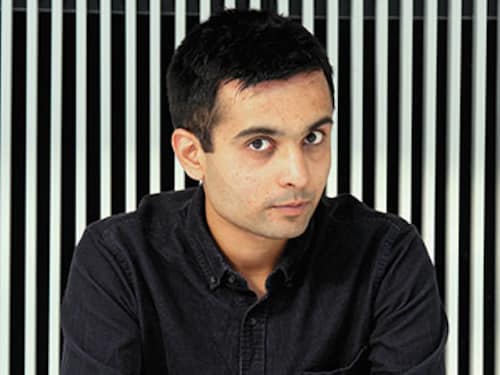Dhairya Dand: Blending imagination and reality
From shoes that guide you to your destination, to touchscreens that stretch and bend, 25-year-old Dhairya Dand's designs boggle the mind


Dhairya Dand | 25
Category: Design
Dhairya Dand is designing a building that will respond and react to its environment: During the day, cells in the building’s ‘membranes’ will open up, allowing for more ventilation at night, it will generate and conserve warmth. This biotechnological construct, which mimics the natural world, is not a dream. It is the young inventor’s reality, and future. “It’s still at the conceptual stage, and we will be making a public announcement this summer,” says Dand who, until three months ago, was a researcher at MIT Media Lab, an interdisciplinary laboratory at the Massachusetts Institute of Technology, Boston, USA. He’s currently an adjunct professor at The Art Institute of Seattle.
Dand’s Seattle factory-studio, christened oDD, is a hive of activity: He’s experimenting with ways to fabricate and manufacture new materials. His ambitious plan to design an organic building is not a flight of fantasy. His past inventions show that imagination and reality are simply two sides of the same coin.
In 2014, he was awarded the Wired Innovation Fellowship for his interactive designs such as the SuperShoes. “They are inner soles that you can insert into a pair of shoes to transform them into SuperShoes,” says Dand. The soles interact with a wearer’s smartphone and use its location and data services. Users can input their food and shopping preferences, hobbies and other interests online. With this information, the shoe becomes a tour guide, GPS map, and can serve reminders for appointments. Information is communicated with the help of a tickling interface: If the left toe is tickled, turn left a nudge on the right toe means take a right, and so on. It will be featured in an exhibition curated by the Victoria and Albert Museum, London, and will be part of the museum’s permanent collection. The concept has also been “taken up” by a shoe manufacturing company.
Last year, Dand was named an Ink Fellow, a programme that identifies and supports innovators across disciplines. “Dhairya’s sense of design has fun, surprise and smart thinking, sprinkled with an uncanny Indian sensibility,” says Lakshmi Pratury, host and curator, Ink Conference.
Dand’s design sensibility is rooted in his childhood in Nashik, Maharashtra. He abhorred the rigidity of school but revelled in art and craft, and learned the rudiments of design from his father who was a plumber and carpenter. From his mother, a homemaker, he inherited a love for philosophy and mythology. “My mother’s stories are part of my imagination,” he says.
Magic and reality intersected when he first saw a computer at the age of 13. “It was at a mobile science fair that had come to my village. I played a game on it it was magical. Until then, for me, everything that humans could create was physical. Suddenly, I saw something we had created with imagination.” And so began his love for computers and programming.
He learnt how to code, moved to Mumbai, and started selling computers which he would assemble from scratch. This helped pay for his education at Veermata Jijabai Technological Institute (VJTI), where he studied computer science. In his second year, he interned at the Industrial Design Centre (IDC), Indian Institute of Technology, Bombay. Dand was hooked to this world of interaction design, and spent all his free time at IDC, attending classes unofficially. “I didn’t enroll at IDC. I just spent a lot of time there.” He returned to VJTI only to sit for his exams. “I barely scraped through.”
His need to invent and design took him to National University of Singapore on a fellowship (he designed flowers that could bloom or droop in response to a user’s personal relationships), Cambodia, where he made toys from e-waste, Uganda (he was part of Unicef’s Innovation Lab), and Tokyo to work in a research lab for a sex toy company. He helped build a kissing device that could be shared by couples in long-distance relationships. Through his work in Tokyo, he began to comprehend how humans used their senses. “We don’t just hear and see through our ears and eyes we also understand the world through our skin,” he says.
In 2012, he got the opportunity to work as researcher and designer at MIT Media Lab. “I found happiness there. This was a place where it did not matter how much you scored, whether you went to school, or, whether you finished school. All they cared about was what you do, what you have done, and how much you believe in yourself,” he says.
In 2014, Dhairya and MIT researcher Rob Hemsley created a 2.5-dimensional shape-changing display with the help of actuators, depth cameras and a silicone screen. ‘Obake’ (pronounced o-baa-keh) shows how people can interact with elastic displays. The viewer can pinch and pull the screen, and data leaps out of it. A Japanese carmaker is taking this display forward to make a concept car for the 2020 Olympics in Tokyo.Dand has won the admiration of industry experts. “What I like about Dhairya is his ability to see connections in completely disparate objects. With each of his projects he wants to push the limits of new, emerging technologies. There is also that element of surprise and delight in everything that he does,” says Rajesh Kejriwal, CEO and founder of Kyoorius Group, which hosts Kyoorius DesignYatra, an annual design festival in India. For Dand, design is about possibilities, without the restrictions of reality. “The reason I create is to understand myself and the world. Each of my projects begins with an emotion. Often, this emotion makes me cry. It makes me observe, ask questions, see things differently. It confuses me, and to find my way, I make I build something with it.”
Here is the full list of 30 Under 30 for 2015 and its methodology
First Published: Feb 10, 2015, 07:20
Subscribe Now